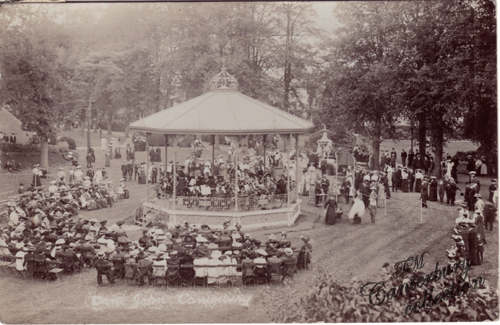
![]()
~ THE DANE JOHN / DUNGEON ~
CANTERBURY
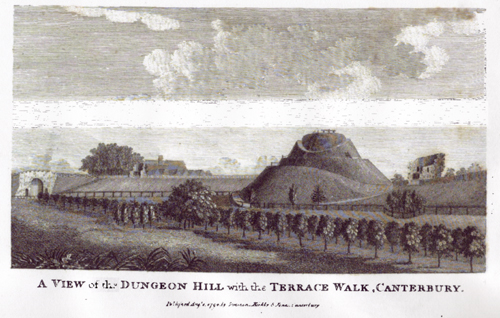
A view of the Dungeon Hill c. 1794
Charles II., A.D. 1684, in his charter of this date, directs a fair or market for cattle, with a court of "Pye Powder" (pied poudre),* to be held annually on the first of March on "Le Dane John Field."
*"Dusty foot", from the
supposed condition of the shoes of the suitors and others coming from
the country places
Entrance to the Dane John, Canterbury - a postcard in my collection
1794 "At the close of the last century, James Simmonds, an alderman, banker, and for some few years M.P. for the city, obtained a grant of the mound and grounds from the Mayor and Corporation for the term of his life, and subject to certain conditions respecting the rights of the citizens. On the 12th January, 1802, however, as recorded in the Burghmote book, Alderman Simmonds resigns all claims upon the Dane John Field, and surrenders his lease to the Corporation. An extract from his "Remonstrance," for so it may be called, will explain the reasons which induced him to take this step, and at the same time will give a history of the Dane John Field at this period.
Alderman Simmonds writes in an injured tone, and in a grandiloquent style: The Corporation having accepted the surrender, resolve henceforth to devote the Dane John Field to recreation and amusement of the inhabitants, provided the latter are willing, by subscriptions or otherwise, to keep the grounds in order, and conserve the recent improvements.
Alderman Simmond's remonstrance is as follows: "That he had laid out 1,500l. in improving and beautifying the grounds and buildings; had erected a brickway to support the Terrace that leads to the Ridingate, and paid Mr. Marseille* (who had a garden close by) 30l. per annum, to keep the grounds in order, besides allowing him the grass." The Alderman then adds: "When I first solicited the Court of Burghmote to permit me to alter the form of the Dane John Field, I had no other intention than, after having made that alteration, to have surrendered it again to the court in such a state as I conceived they would think most improved from that in which I found it, and in which rude and irregular shape it had lain beyond the memory of man, and at many parts of the year inaccessible to the public. The possible improvements of the ground, the various beauties of which there was so great a capability throughout the field, and the pleasure likelier to result to all the inhabitants of my native city from this undertaking, let me into a much greater expense than I had at first proposed. For this expense I have felt myself amply repaid by the universal satisfaction expressed by my fellow citizens, and by the repeated thanks by which I have been gratified by all ranks of people. Indeed, they have done me the honour to say "the Dane John Field has become a public ornament to the city, conducive to the pleasure and health of all the inhabitants. To this place travellers and strangers resort as to a public spectacle, and, astonished at the singular beauties of the hill, the banks, and the plantations, have all of them declared that no city in the kingdom has within its walls any public walk or place of recreation to be compared with this."
The Alderman then goes to say why he had solicited this grant of public ground during his life time, that he might beautify and improve it; and "that having expended more than 1,500l. in transforming a rude and irregular piece of ground into a beautiful promenade, and supporting the same at an expense of 40l. a year, he is placed in a list of defaulters with his poor neighbours by the court of guardians, and summoned before the justices for the non-payment of a poor rate of eight pounds per annum! When I saw the summons, continues the Alderman "I exclaimed "Gracious Heavens! what a return is this!" It was, we must own, hard and short sighted on the part of the guardians; if they had legal power to waive making the assessment, which possibly might have been done could it have been shown that no profit was derived from the grounds, especially as it was a place for public recreation.
Amongst the trees then planted on the Dane John, poplar trees seem to have constituted the avenue. They must have flourished too, for twelve years later, every alternate tree, then valued at forty shillings per tree, was ordered to be cut down. All the poplars, save one or two only, have long since disappeared.
This place of public recreation, thus abandoned by Alderman Simmonds, the public erecting on the mound and ungraceful pillar to his memory, soon again became a waste - unkempt, untrimmed, if not uncared for, until some years later the Corporation did what they should have done long before, took it entirely under their charge, and appointed a ranger and assistants. Its present annual cost is now from 180l. to 200l. per annum.
The Canterbury Fair was kept in the Dane John for some years after Alderman Simmonds had relinquished his wardship over it. By an order of Burghmote, dated 2nd September, 1814, it was enjoined during the fair time, "that no damage be done to the walks, slopes, and fences."
In July, 1812 the iron fence on the wall leading to the Ridingate was erected. The city tower on the Dane John next to the Ridingate was removed in 1769. The gardener's cottage was erected by Alderman Simmond's in 1812. It was supplanted by a more commodious building in 1877.
Somner describes the Dane John Mound as orginally entrenched, and, when first cast up, as lying outside the city. If this be a correct notion, it would be a fatal objection to the theory entertained by some antiquaries that the wall outside the mound was part of the circuit of Roman Canterbury.
At the close of the 17th century, the Dane John was used as a place for military executions. From entries in the book of the parish clerk of St. George, kindly communicated by the rector, we learn: "9 November, being All Saint's in the year 1694, a solddyer in the regt. of Col. Coote was shott to death on the further Dane John, the day above written, and buried in the chapel yard in common ground." Again, July 9, 1696, "A soulger in Col. Tittcome's regt. was shot for desertion, and in the nether Dane John, and buried at the same place where he was shot."
*Among the prints relating
to the history of the city, in the Canterbury Museum, is an engraving
of the Canterbury Catch Club in 1826; a large company of convivialists
at a table, each with a churchwarden pipe, or yard of clay, and a tankard
or a wine-glass or a spirit rummer before him, and the motto "Harmony:Unanimity"
on the ceiling above. The names of these jovial whiskered fellows are
provided in a key, all of them save two earning their living, the president
being Mr. Charles Delmar, brewer, and the two exceptional members without
any low traffic with toil being Mr. Marseille, gentleman, and Mr. Hollingbury,
gentleman. If the name of Mr. Wickfield lawyer, is not here it is because,
I feel sure, he joined later than 1826"
1521. A hall is built at the Dungeon, against the coming of the king's commissioners, for the inquiry of every man's value, &c. and fish are provided from Stodmarsh to be given to them. HT
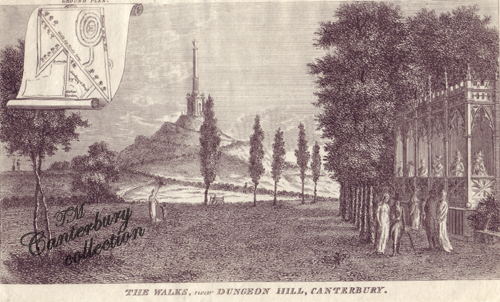
The walks, near Dungeon Hill, Canterbury, dated June 1808, from a print in my collection
*showing the original gothic arbour that was located there
1820, New Monthly Magazine - Canterbury. The orchestra upon the Donjon Field, has been lately removed. An adjoining piece of land having been presented to the public by Mr. George NEAME, a subscription is commenced for the purpose of enclosing it, extending the shrubbery, and making further improvements, under the direction of a committee of the corporation of the city.
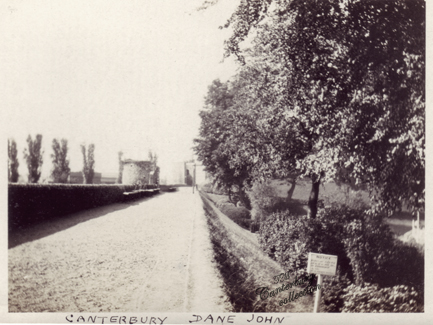
1643. In July, the ordnance on the Dungeon are to be watched day and night by the housekeepers of the city, and the fort made defensible, and fit for a watch, in wards in order one after another, vix. four in the day time, and ten in the night. In October it is directed, that there be twelve watchmen for the day, and 14 for the night; of whom 3 shall be at St. George's gate, 3 at Westgate, 2 at St. Andrew's Church, and 6 to walk the rounds in two companies. The ordnance, at the Dunjeon-hill and Old Castle, are afterwards ordered to be dismounted. In 1647, and the following year, all the ordnance of the city, likewise the posts, timber and boards set at the gates belonging to the fortifications, are disposed of for the city's use. HT
___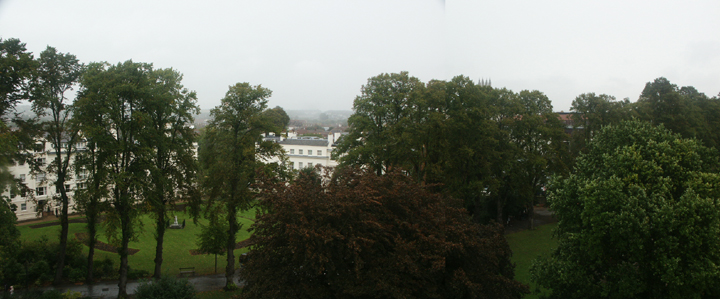
A recent view from the monument 2006

A map detail from Felix Summerly's Hand-book for the city of Canterbury, 1843
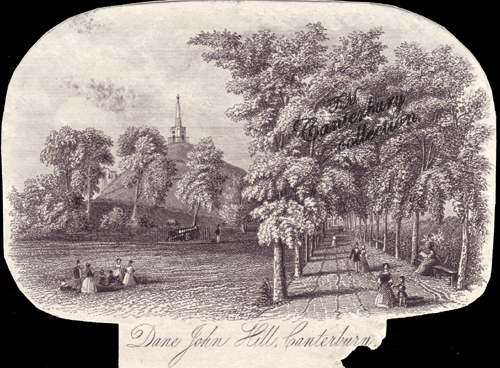
"Two or three hundred yards from thence is a Danish mount, giving its name to the manor*, from whence we have a pleasant prospect of the city and the county round about it. It is commonly called Dungil, or Dane John Hill, some suppose from being thrown up by John, a Dane, others from the French word donjon or dongeon, a high tower in old fortifications. This, and two smaller mounts not far from it, are looked on as works of the Danes when they besieged our city in King Ethelbert's time. The city wall was afterwards carried round so as to take in this high one for its defence.
Going from Wincheap eastward without the city wall, we see the two little mounts mentioned, behind one of which is a range of buildings, once outhouses to the old capital mansion of Dane John."
*The Lord of this Manor being removed to a distant county, and the house so disagreeably situated as not to invite a good tenant, it was pulled down some years ago. 1777

The Fountain in the Dane John, a picture postcard in my collection
"1460 - William Pennington executed by the citizens for endeavouring to prevent free ingress to the Dane John Grounds, and appropriate them for his own use." CV
1557 - Commissioners were sent to Oxford, where they Burnt the English Bibles and Heretical Books they cou'd find; and took up the Body of P... Martyr's Wise (that lay in Christ-Church Cathedral) who they said was a Heretic and buried it in a Dunghil* CHE 1714 *I think it's possible that they buried it in the Dane John

Dane John looking west c. 1890's, on the left of the drawing you can see the Russian gun that was captured at Sebastopol
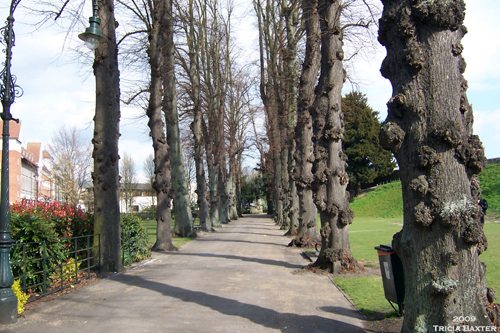
"On the top of this hill, some time since, there stood a windmill, which has been removed many years ago. Leland, who wrote in king Henry VIII.'s time, says, in his Itin. vol. vii. p.145. "Many yeres sins men soute for treasor (since men sought for treasure) at a place cauled the Dungen where Barnhales house is now and ther yn digging thei found a corse closed in leade."
"The Dungeon, or Danejohn-field, for it is at present known by both these names, lies near the site of old Riding-gate, adjoining but within the walls of the city, at the south-east corner of it, and on the west side almost to the ditch and wall of the castle bayle. In antient deeds the name is variously written Dangon, Daungeon, and Dungen; names all much alike and of the same import.
A card in my collection - posted October 31, to Master A. Greensmith No. 74 Millars Road, Bush Hill Park, Enfield
Dear Alf how do you like this for a band stand it is near the Dane John. I went to the top on Friday night it is a lovely sight. I should like you to see it you can see from miles, you must send me a nice card, hope to hear you are keeping well with love Bevthur? Hope to see you soon ....little kid
The Whitstable Times and Herne Bay Herald, Saturday, June 30, 1877 - Band on the Dane John. In reply to a letter from the Mayor (W. H. Linom, Esq.) written at the request of the Chamber of Trade, Colonel Conyers Tower, the commandant of the Cavalry Depot, has kindly consented to allow the Depot band to play on the Dane John every Thursday evening during the summer months from 5 to 7 o'clock. It is to be hoped the inhabitants will show by their attendance in large numbers that they appreciate the kindness on the part of the commandant of our garrison.

At the south-east corner of this field, close to the city wall, there is thrown up a vast artificial mount, or hill, now to all appearance circular, having a deep ditch, from which no doubt the earth was taken round the other part of it; it is a great deal higher than the wall ever was, when entire; insomuch, that from the top of it there is a clear view over the whole city below it, as well as a great extent of the adjacent country; the field itself, before the late alterations, consisted of very uneven ground, and whatever had occasioned it, had never been levelled. On the outward, or opposite side of the wall to the above mount, the city ditch and a high road only separating the two, is another artificial mount, of a much smaller size and not half as highz.
This place was esteemed of such consequence, that it gave name to the adjoining manor of the Dungeon.
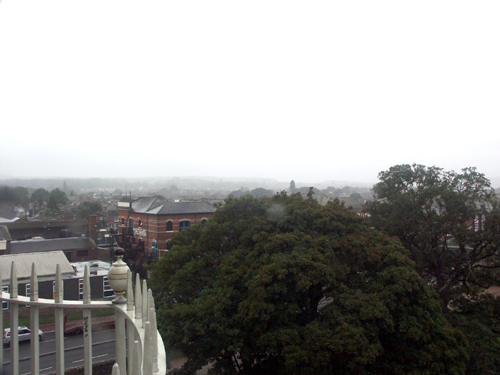
A view from atop the monument (my photograph 2006)
The original of its name is conjectured to have arisen from its having been the Danes work, and to have been from thence corruptly called Dangeon and Daungeon, for Danien or Danes-hill; and that, because it was either their work against the city, or of the city against them; but the former appears, by what follows, to be much more probable. Indeed, it seems to have been the proper work of the Danes, the great and frequent molesters, invaders, and wasters of this city, and most likely at the time when in king Ethelred's days they besieged the city, and after twenty days resistance, took it by storm, and then destroyed both city and inhabitants.
Whoever well observes the whole of this spot, will plainly see, that the works above-mentioned, both within and without the present wall of the city, were not counterworks one against the other, as the common opinion is, but were once all one entire plot, containing about three acres of ground; the outwork of a triangular form, with a mount or hill (what appears to be now two, having been but one of a pearlike shape, till cut through, as will be noticed hereafter) intrenched round within it, and that, when first made and cast up, it lay wholly without the city wall, and that part of the mount which now forms the larger one and most part of the outwork likewise towards the north of it, for the greater security of the city, has been taken and walled in, since that side of the trench was formed, which encompasses the smaller mount now lying without and under the wall, (fitly meeting with the rest of the city ditch) after both sides of the outwork were cut through to make way for it, at the time of the city's being walled and inditched; a conjecture that must seem probable to any one who marks and examines the place with attention."HT 1793
z - The field or meadow, at the north west corner of which this small mount stands, is of like uneven surface as the other. It is usually called the Martyr-field, from several persons having been burnt in a large hollow or pit at the south end of it in queen Mary's reign, on account of their religion. See Fox's Martyrs, vol. iii.
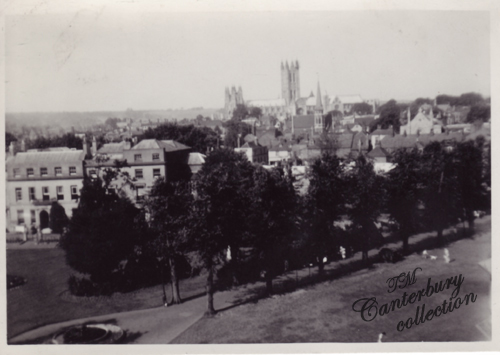
A view from the Dane John prior to WW2, a photograph in my collection
"Some labourers employed in trenching the land adjoining the Don-Jon field, came in contact with a steamed grave containing the perfect skeleton of a man, who, from the teeth which remained in the jaws, appeared to have been of great age. The grave was steamed in chalk, and from the composition of the mortar with which it was worked, as well as from some old foundations near it, is conjectured to have been within the site of the church of Saint John, which it is said formerly stood thereabouts. From the appearance of the grave, it is supposed to have remained undisturbed many centuries." AR 1820
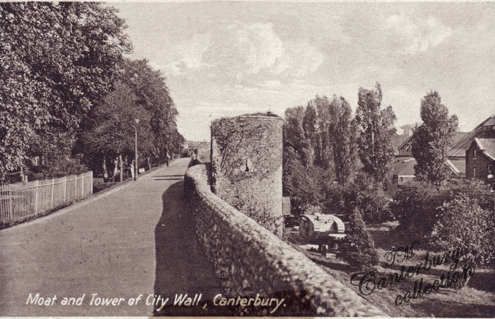
The city wall with the old WW1 tank on the right, and the capstan sitting in the moat area (the tank I believe was removed for scrap in WW2)
1630. Tents are to be made for the relief of the infected with the plague, and set up in the lower part of the Dungeon, where most out of sight of passengers. Assessments are raised on the inhabitants for the support of infected persons. The like in 1637, 1647, 1665 and 1672. HT
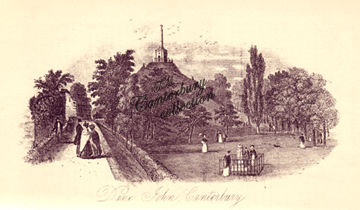
Dane John Canterbury showing the wall and momument, on the right hand side you can see the sundial by John Weekes surrounded by the iron railings
"On the lawn is an exquisitely sculptured sundial by the celebrated Weeks, a native of this city. On the pillar, in bold relief are classical figures of the Seasons."
(See Weekes family)
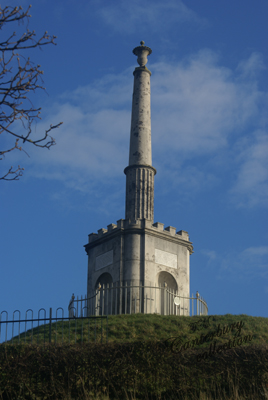
The Simmons Monument 2011

October 1802 - A subscription has been lately opened, and now lies at the banks and libraries in the city of Canterbury, for the purpose of erecting, at the expence of the public, an elegant stone pillar, on the summit of the Dane John Hill, with iron rails and commodious seats around it, "in commemoration, and expressive of, the costly improvements made on the Dane John Field, in the year 1790, by Mr. Alderman Simmons, and of his other public services" as it is expressly stated in the papers; also to commemorate the "reslolution of the mayor and commonalty of the city, to devote the terraces, walks, and field, in perpetuity, to the public use." N.B. A drawing of the intended pillar has been left for public inspection at Mr. Bistrow's Library. MM 1802
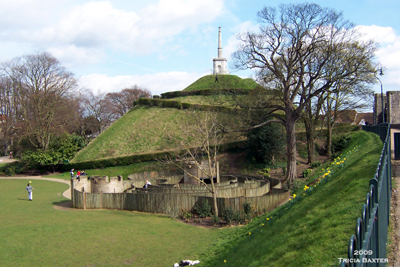
"To the south is Dane John Field, so called from a lofty conical mount said to have been thrown up by the Danes when they besieged the city; or, more probably, from its having been the site of a keep, or donjon. It is tastefully laid out in spiral walks and shrubberies, and planted with lime trees: on the city wall, by which it is bounded to the south-east, is a fine broad terrace, with declivities covered with turf; and on the promenade is a sundial, supported on a marble pedestal sculptured with emblematical representations of the seasons, by Mr. Henry Weeks, a native artist. On the summit of the mount, from which a panoramic view of the city and its environs is obtained, a stone pillar has been erected, with tablets recording, among other benefactions, a vote of £60 per annum by the corporation for keeping the promenade in order."1848
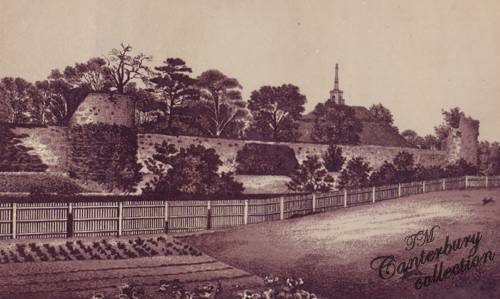
Simmons Monument and City Walls and Towers c. 1890's
"There are several entries in the Records in respect of the above locality. It appears to have been the property of the citizens from time immemorial. Here they shot at the butts with arrows, and here at a later period they practised at the target with "blundering musquets," culverins, and other fire-arms.
Much speculation has been hazarded respecting the origin of the Mound, and some antiquaries have considered it to be an erection analogous to Silbery Hill, and other tumuli, coeval perhaps, with the ritual of the Sabean or Druidical form of worship.
The name assigned to the Mound is variously written"Totam terram nostram quam habuimus ad Dangonem," Danzonem; also, "in campo qui voctor Dangun," in a deed, 14th Edward I.; likewise "juxta le Daungeon," as also in old rentals of the Cathedral, *and Roger Brent in his will, dated 1486, mentioning his manor there, calls it so, and the hill hard by "Dungeon hill." The common and prevalent impression is that the name is a derivative from the Danes, as if of the Danes, "Danes' work," being the production of these marauders in some attack upon the city. But its propinquity to the Castle, and its similarity to the Donjon Mounds commonly erected near the stone castles of the Norman proprietors, appear to point out both its origin and its denomination. Leland, who wrote in his Itinerary in the time of Henry VIII., informs us that many years previous to his time, men seeking for treasure "at a place cauled the Dungen, where Barnhale's house is now, and ther yn digging, thei found a corse closed in lead." On the Mound, we are also informed, an ancient windmill once stood. There were anciently two mounds, and the one which remains was once covered with oaks, which, in the time of Elizabeth, a certain Hugh Johns was permitted to cut down, "provided he plant twenty ashes or elms and keep them to grow."
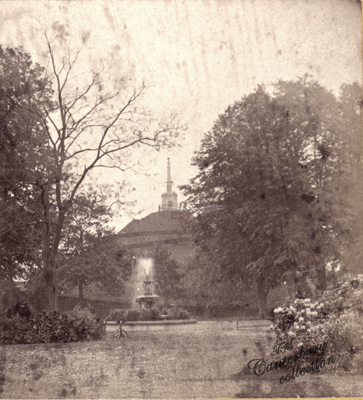
From time to time, however, the right of the citizens to take pastime and recreation in this ground appears to have been disputed, and the Dungeon field, modernly "the Dane John," seems to have been constantly a subject of contention between them and the parties to whom the Corporation leased the manor. Thus a certain William Pennington cuts a deep dike between the Mound and the Ridingate, to prevent the ingress of the citizens into their accustomed pleasure-ground. Pennington while his party remained in power, set the Commonality at defiance; but no sooner had the battle of Northampton given a temporary ascendancy to the opposing faction, than "the said William Pennington," according to the deposition of a witness upon a trial, "was summarily beheaded nigh unto the said ground, owing to the great grudge which the city had against him." But why behead him? There were gallows enough in the old city? We have it on record that there was erected a gibbet fifty feet high in the reign of Edward I., opposite the Rush market, upon which the earl of Athol was hung for taking part with Baliol against the King of England in his Scottish wars, hung, but cut down before he had expired; his head was hewn off, and his body burnt. There was a gibbet at the Bullstake upon which one of the Mayors of the city, Nicholas Faunt, is said to have been executed for taking part with the insurgent Falconbridge. There was a gibbet at Oaten Hill. This spot level enough now, was one of some elevation, and upon it stood a cross. There was a gibbet at Well Lane, near the Mote Park Wall, leading to Fordwich; and we find that in the reign of Edward IV., a commission was set on foot to plant a gallows at Chalder's Elm." COT
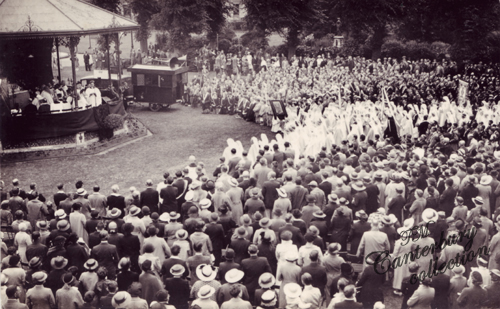 ____
____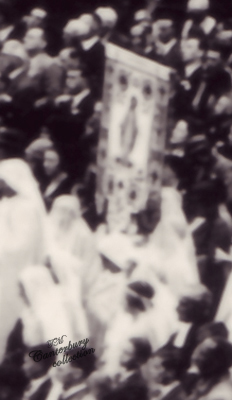
Can anyone tell me when & what this gathering in the Dane John was all about?
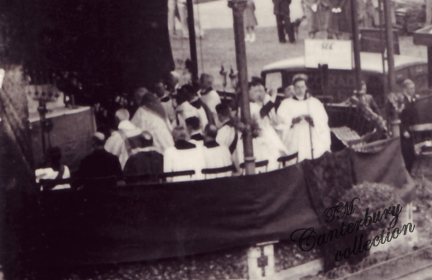
"This from early times was the citizen's ground where they indulged in sport or archery - and in after years- in musketry practice at the butts. There where originally according to Brent - two mounds, a lesser which stood on the other side of Watling Street, overlooking the present cattle market, and the greater which still remains. In 1286 it is mentioned in some old writings and called "Daungeon," and it is probable, if the name is a corruption of "Donjon," that it was at one time surmounted by a small keep, and used as a look-out mound for the Castle guard. In 1643 it did serve such a purpose, an improvised guard with ordnance being mounted there. A spiral path leads to the summit on which stands a memorial, signalizing the improvements carried out by Alderman Simmons in 1790.
The path running along the embankment traverses the rampart of the old city wall, from which the moat below, now converted into a market garden, may still be seen. The river was formerly diverted to fill it. Four of the watch towers remain, the first which we pass at the top of the ascending path being known as the White Cross Tower, so called from the cross of Caen stone let into the face of it below to commemorate the martyrdom in the Martyr's Field opposite. It can be seen from the roadway beyond when the pear tree below is not in leaf.
An avenue of lime trees runs through the gardens, which though small are tastefully kept. In the centre is a stone fountain; and on the lawn to the left is a sundial, the pedestal of which is beautifully sculptured, each face presenting a classical representation of the Seasons with appropriate designs beneath. It is the work of the sculptor Weeks, who was a native of the city. On the opposite lawn stands a Russian gun captured at Sebastopol."AHB 1891
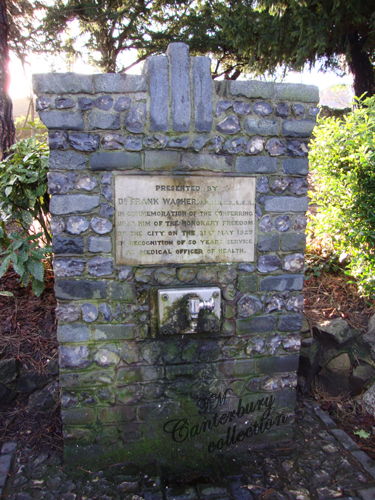
Music on the Dane John - This week Mr. W. T. Harvey's excellent band performances on the Dane John have been held under much more favourable weather conditions. At the special illuminated concert on Wednesday evening there was a capital attendance, both within the enclosure and outside. The bandstand, with its festoons of red and yellow electric lamps, had an extremely pleasing appearance, and the musical programme was thoroughly worthy of the occasion. Miss E. Marsden Owen sang very capably, and with so much charm that she was re-called on each of her appearances. The orchestral programme, too, was a remarkably good one, one of the gems being the delightful Bach-Gounod meditation "Ave Maria," in which the solo violin part was admirably taken by Mr. Cecil Gann**, the leader of the band......etc. kg1907
**Mr. Cecil Gann lived at Cremona Villa on Whitstable Road in the early 1900's, and was a Professor of Music who was born in Canterbury.
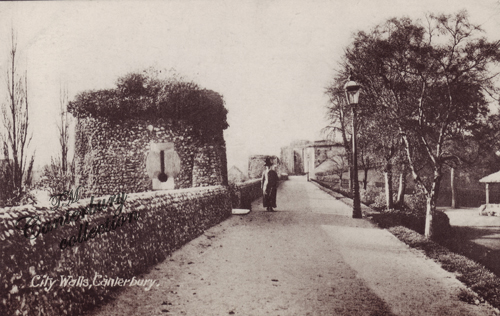
The City Walls
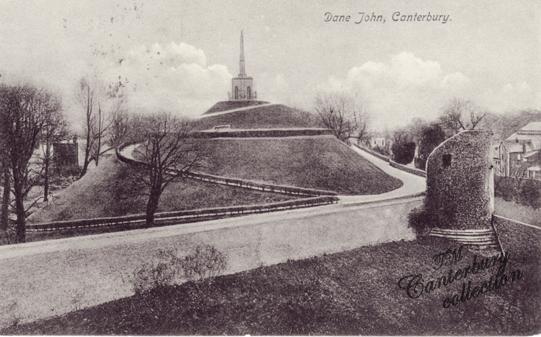
"A view of the Dane John, city walls, Towers and Moat", one of my old postcards
The walls with which the Romans surrounded it, appear to have been built of flint and chalk, and to have included an area a mile and three-quarters in circumference, defended by a moat one hundred and fifty feet in width; of these walls nearly the whole is remaining, and on that part which forms the terrace of the promenade called Dane John Field, are four of the ancient towers in good preservation. 1848




![]() A
selection of my old postcards
A
selection of my old postcards
There are notes on the Dane John in "The Antiquary", published 1873 E.W. Allen
